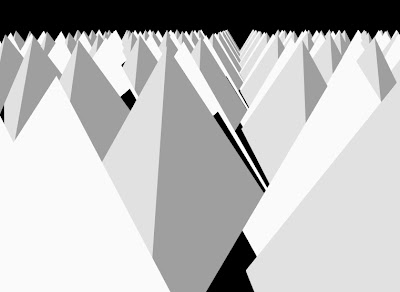MINIATURE LANDSCAPES
It is now well on the way to the end of the trimester, and I now have designs and models to assess. Some of these I won’t discuss here, and instead show at finals, but its interesting to look ideas and experiments have worked and have not worked.
To start with, I produced a design that attempted to rescale the monolithic. The Egyptian pyramids, the ultimate monolith, is possessed of a sacred nature. But my own experiment in tiling tetrahedrons at minute scale created a landscape of the profane, a grip tread less attractive than diamond plate. Is it the change in scale or the repetition or both that produces this (unwanted) effect? Is simple geometry monolithic at large scale but banal at small scale (witness the dice)?
Or is it that the miniature require complexity to become sacred? When I introduced a fractal style recursion, a growth of smaller and smaller tetras from their skin, the forms became more interesting but still lack any sense of being subliminal, simply because, I believe, the basic element remains unchanged.
On the other hand I recently discovered the beautiful and tiny forms that can be produced by the actions of magnets on ferrofluid, which is an oil filled with iron particles and thus magnetically reactive. In some ways these landscapes resemble the tetrahedral patterns I modeled in Rhino a few weeks before, but are far more sensory. Is this because they are actual rather than virtual? Is the transformation from an ordinary liquid to a strange geometry, and the movement involved, that makes it so absorbing of attention? Or is the the subtle complexities and randomness of the structural repetition? I ask myself again: does the miniature require complexity to become sacred?
In the case of my family of chairs, it is perhaps the opposite. At the smallest scale we witness an inability to contain detail due to the thickness of material. At the same time, the thickness of the material becomes structural and defines the aesthetic form. At the other end of the scale, with the larger, thinner chairs, this structure becomes merely decorative and its structural purpose is obsolete like a vestigial organ. These characteristics when seen together in all the chairs have the ability to communicate information about their context and family relations. And this is not just conjecture; to test this idea I produced an online survey and sent it via Facebook. The first page of the survey included a picture of the individual chairs at an equal scale i.e all the same size or 1:1. A few pages later the chairs were shown again, this time in relation to one another. Both times, users were asked to rank the chairs and comment on what they did or did not like about them.
The survey can be accessed at this address:
http://www.surveygizmo.com/s/85951/furniture-and-objects-survey
Out of the 30 or so answers I have received back so far, a large number of users understand that the relationship between the chairs i
s more than just aesthetics decisions of weight and form, but an expression of a genetic code…. but only after they had seen them in context together. Then the majority of users change their opinion and rank the chairs differently; Chair E, the fat little baby, disliked when shown at 1:1, becomes popular when shown dwarfed by his relations. His immaturity as a chair is assessed alongside his potential as a chair.

 When discussing this smallest chair, I can say that the material which binds all the chairs together is best expressed at its smallest scale because its lack of ability to function as a sheet material makes its presence overt. As an individual, it is anomalous. Just as a baby is representative of the full grown adult it shall become, packaged in the same material of skin, blood and bone, but at distorted scale. A giant baby may be monstrous, but at its naturally tiny scale, a quality manifests itself: cuteness.
When discussing this smallest chair, I can say that the material which binds all the chairs together is best expressed at its smallest scale because its lack of ability to function as a sheet material makes its presence overt. As an individual, it is anomalous. Just as a baby is representative of the full grown adult it shall become, packaged in the same material of skin, blood and bone, but at distorted scale. A giant baby may be monstrous, but at its naturally tiny scale, a quality manifests itself: cuteness.












